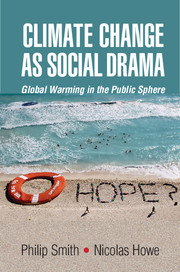Book contents
- Frontmatter
- Contents
- Acknowledgments
- 1 Introduction: The Problem of Climate Change
- 2 Climate Change as Social Drama
- 3 Narrating Global Warming
- 4 An Inconvenient Truth: The Power of Ethos
- 5 Climate Change Art: An Illustrative Failure?
- 6 Climategate and Other Controversies
- 7 The Climate Conference as Theatre
- 8 Local Dramas: The Places of Climate Change
- 9 Conclusion: The Show Must Go On
- References
- Index
5 - Climate Change Art: An Illustrative Failure?
Published online by Cambridge University Press: 05 May 2015
- Frontmatter
- Contents
- Acknowledgments
- 1 Introduction: The Problem of Climate Change
- 2 Climate Change as Social Drama
- 3 Narrating Global Warming
- 4 An Inconvenient Truth: The Power of Ethos
- 5 Climate Change Art: An Illustrative Failure?
- 6 Climategate and Other Controversies
- 7 The Climate Conference as Theatre
- 8 Local Dramas: The Places of Climate Change
- 9 Conclusion: The Show Must Go On
- References
- Index
Summary
Although emphatic on the pivotal role of character, Aristotle seems to have been in two minds when it comes to the persuasive force of the visual and the visual arts. On one hand, he intimates that the representation of reality is intrinsically fascinating and emotionally energizing for humans:
Objects which in themselves we view with pain, we delight to contemplate when reproduced with minute fidelity: such as the forms of the most ignoble animals and of dead bodies … the reason why men enjoy seeing a likeness is that in contemplating it they find themselves learning or inferring, and saying perhaps, “Ah, that is he.” For if you happen not to have seen the original, the pleasure will be due not to the imitation as such, but to the execution, the coloring, or some such other cause. (Poetics IV, 3–5)
On the other hand, he subordinates visual representation in the hierarchy of the arts: cultural evolution had given rise to more complex and powerful modes of expression. The human instinct for imitation had been combined with those for harmony and rhythm and eventually “gave birth to Poetry” (Poetics IV, 6). Aristotle is clear that this is a more complete art form, especially when it provides the foundation for drama. Within the world of drama itself, he concedes that “Spectacle has, indeed, an emotional attraction of its own” before continuing, “But, of all the parts, it is the least artistic, and connected least with the art of poetry. For the power of Tragedy, we may be sure, is felt even apart from representation and actors. Besides, the production of spectacular effects depends more on the art of the stage machinist than on that of the poet” (Poetics VI, 19).
It would seem that for Aristotle, then, the visual can generate superficial pleasures but not a deep and transformative experience.
- Type
- Chapter
- Information
- Climate Change as Social DramaGlobal Warming in the Public Sphere, pp. 88 - 117Publisher: Cambridge University PressPrint publication year: 2015
- 1
- Cited by

